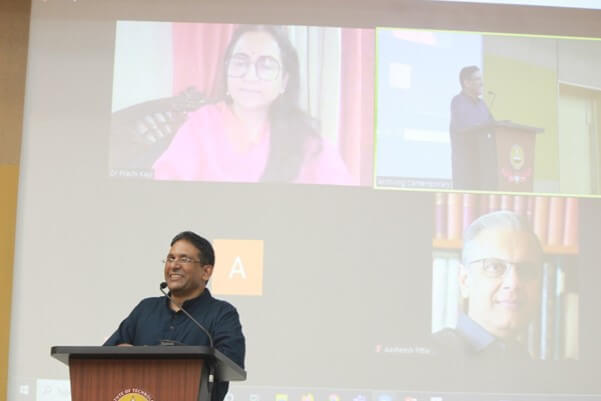Natural History, Women’s Agency and Conserving Bio-diversity: A Report
Amil Varghese and Thamarai Selvan KannanSeptember 12, 2022 | Report-Backs
On April 30, 2022 a half day seminar on “Natural History, Women Agency and Conserving Biodiversity” was held at the Indian Institute of Technology Madras, India (IITM) – coordinated by Dr. John Bosco Lourdusamy of the Department of Humanities and Social Sciences. This was in continuation of other recent events being organised by the scholars and faculty of the Department in the domains of STS and HISTEM, like ‘Archiving the Contemporary’ (coordinated by Dr. Roland Wittje), in April 2022, and ‘Republic of Plants’ in December 2019.
This seminar was organized as part of the Gwillim Project, an international project which is centred around the life of two English sisters Elizabeth Gwillim and Mary Symonds who lived in Madras (now Chennai) in the early nineteenth century and left behind a rich treasure of letters and drawings on the flora, fauna, climate, and ecology of the Coromandel coast and on colonial relations around that time. The program was generously supported by the Shastri Indo-Canadian Institute (SICI). It fructified through the joint efforts of partners at IITM, McGill University, Canada, and Dakshina Chitra Heritage Museum, Chennai.
The event had two components: a Seminar with six speakers, and an Exhibition which had samples of Gwillim Sisters’ paintings – curated by Dr. Geetha Hudson from Dakshina Chitra Heritage Museum. It also projected digital images of IITM campus’ flora and fauna as compiled by Prof. Susy Varughese of IITM.

Dr. John Lourdusamy welcoming the gathering. Seen in the backdrop is Dr. Prachi Kaul, Director of Shastri Indo-Canadian Institute (SICI) [Image courtesy: Authors]
Prof. S. Subramanya’s presentation underlined that the sisters’ work was unnoticed in their own time but in retrospect, they turn out to be one of the first in documenting the birds of the region. The samples shown during the talk captured the full figures of the birds – drawn with fine details. Since Lady Elizabeth Gwillim had trained under landscape artists, she captured the local landscape, people, traditions and environment too with great detail. The talk brought out how rich (in natural environment) the Madras region was for the water birds (47% of sisters’ bird paintings are water birds) – attracting birds from faraway places like Sumatra and Malaysia. It was pointed out that Lady Elizabeth did not venture out much to draw the paintings but rather the birds were brought to her home by bird trappers. Her letters reiterate the point that local actors had contributed a lot in creating and disseminating knowledge during colonial times.
Claire Sabel, Fulbright Visiting Scholar from the University of Pennsylvania, highlighted the relative absence of women’s readings and also the various ways in which women’s sources were characterized and presented in the archives. Paying attention to this kind of absences, helps us in recognizing the agency of the participants from a variety of social and economic aspects. Her talk pointed out that Gwillim sisters’ sources touched upon the gems, stones and the minerals of the region.
Dr. John Mathew, Krea University and Mr. Kumaran from Heritage Centre, IIT Madras presented papers that highlighted other actors and media in documenting the natural environment and various species of 19th century Madras Presidency. Dr. Mathew in his presentation highlighted the rise and fall of the Madras Journal of Literature and Science and Madras Literary Society. The contributors to the Journal were mainly colonial administrators of different kinds. But in its last days, few Indians too contributed. Dr. Mathew pointed out that financial constraints, lack of subscription and low level of interest in natural history were the main reasons for the decline of the Journal. Mr. Kumaran brought to the fore the naturalist Walter Elliot (19th century CE), who had meticulously documented various mammals of the Coromandel coast. He had also undertaken many hunting expeditions along with Walter Campbell who described Walter Elliot as ‘a Sportsman Naturalist’. His work is very significant considering that very few at that time had worked on Indian mammals.

College students engaging with the sample paintings by the Gwillim Sisters. The Exhibition was curated by Dr. Geetha Hudson of Dakshina Chitra Heritage Museum
The final presentation was by Prof. Susy Varughese of IIT Madras, who showcased IITM campus as a model of a vibrant natural ecosystem. She highlighted the importance of human and “more-than-human” players contribution in maintaining the ecosystem. She also emphasised the awareness one needed to have in the 21st century in preserving wilderness and wild animals in an urban built environment. She presented a captivating documentation with visuals captured by a trap-camera set up in the campus as part of an international collaborative study of natural habitats. It showed the habitat change over a period of time across rainy and non-rainy seasons in the campus. There were many lessons to take home from the talk on the importance of conservation and on looming dangers like the great number of species becoming extinct and birds not coming back to Chennai due to disappearance of water bodies – as pointed out by Prof. Subramanya.
Amil Varghese is a Junior Research Fellow in the Department of Humanities and Social Sciences, IIT Madras, working under Dr. John Bosco Lourdusamy. He is broadly working in the domain of medicine and healthcare in tea plantations in colonial south India for his dissertation project.
Thamarai Selvan Kannan is a PhD candidate in the Department of Humanities and Social Sciences at IIT Madras, working under Dr. Roland Wittje. His research interests are in the areas of history of science, technology, craft, environment and education.
Published: 09/12/2022
